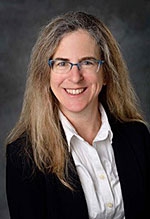
Professor of Physics and Astronomy, Michigan State University, and President of AAS
Megan Donahue observes clusters of galaxies and massive galaxies with the aim of answering questions in cosmology and galaxy evolution. She is currently learning how supermassive black holes in the centers of galaxies regulate their own growth by controlling the thermodynamic state of their fuel supply - the galaxy’s baryons. Most of those baryons inhabit a volume of space much larger than where the stars are, a volume known as “circumgalactic”. Clusters of galaxies are perfect sites for studying how the baryons interact with dark matter, because in clusters, these circumgalactic baryons are hot enough to be revealed by their electromagnetic radiation (in X-rays). There are no “missing baryons” in clusters of galaxies. Such studies have led to important insights regarding the role of feedback in the evolution of individual galaxies, even lower-mass galaxies.
Professor Donahue is President of the American Astronomical Society (2018-2020). In 2016, she was named a Fellow of the American Physical Society for "advanced cosmological observations and analyses of galaxy clusters, and of the relationship between the thermodynamic state of circumgalactic gas around massive galaxies, the triggering of active galactic nucleus feedback, and the regulation of star formation in galaxies" after nomination by the APS Division of Astrophysics.
Talk title
"AAS Graduate Education Diversity and Inclusion Task Force and its 2019 Report"
Abstract
I will highlight the motivations for the AAS Graduate Education Diversity and Inclusion Task Force, its membership and process, and I will provide a summary of the findings and recommendations of its report. The report makes recommendations to graduate programs in astronomy on the general topics of recruiting and retention of a diverse graduate student population, taking advantage of evidence-based recommendations from social science. It also recommends the AAS and the AIP track progress through surveys of department student demographics and the establishment of a website to monitor, through voluntary self-reporting, the efforts of individual departments.
